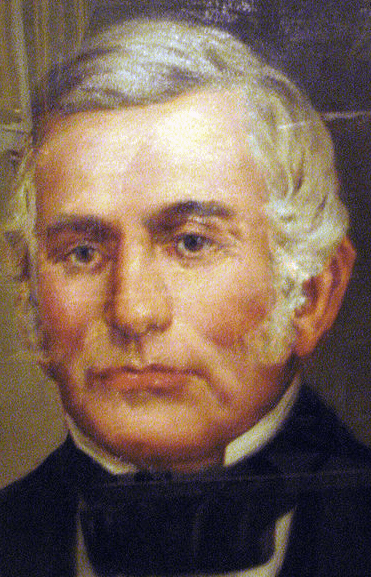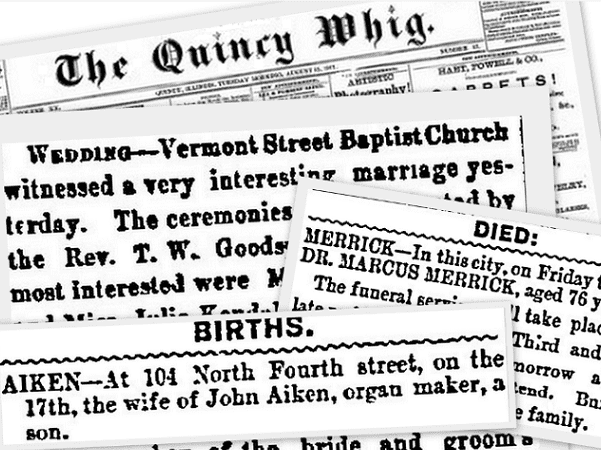Introduction: In this article, Gena Philibert-Ortega searches old newspapers to learn more about a relative on her family tree who – she discovered – was very much involved in the war in Missouri against the Mormons during the 1830s. Gena is a genealogist and author of the book “From the Family Kitchen.”
Family history can seem deceptively easy when searching for your ancestors in an online newspaper archive. Type a name into a search box and you are rewarded with stories that can help you better understand your family history. Learning about specific individuals is one way to go about newspaper research, but it’s not the only way to research your ancestors.
The Time & the Place
For me, what I love about newspapers is their ability to help me better understand not only my ancestor’s own life – but their time and place. Getting to know what was going on and what they were a part of, often in reports that don’t even mention my ancestor by name, is an essential part of family history research.

Moses G. Wilson & the Mormon War
One of my long-term genealogy research projects involves Moses Greer Wilson (1795-c.1868). I was first introduced to Moses via a research trip I took to Texas 13 years ago. I was researching a branch of my paternal family tree when I “found” Moses, who was the second husband of my 4th great-grandmother, Sophia Bell Lewis Wilson. I’m not descended through that marriage so I didn’t pay too much attention to researching him. After all, the information I really needed involved their son-in-law, my 3rd great-grandfather.
During that Texas trip we found copious amounts of deeds and other materials about Moses Wilson, but due to the high cost of courthouse photocopies (remember this was before smartphones and other mobile devices, back when we thought having a laptop was a big deal) and the fact that he wasn’t our focus, we ended up limiting the info we collected about him.
Fast forward about 10+ years, when I received an email from another genealogy researcher about Moses. She shared his timeline with me that included the years previous to his marrying my ancestor, his second wife. One of the timeline facts involved his living in Jackson County, Missouri, in the 1830s.
For anyone who is Mormon or familiar with Mormon history, the 1830s in Jackson County, Missouri, were tumultuous years for the Mormon Church and its members. As I started Googling about Moses, I realized that he wasn’t simply present during that time – he was one of the ringleaders in the effort to remove the Mormons from Missouri. A brigadier general in the Missouri Militia who participated in the Mormon War, he was also acquainted with Governor Lilburn Boggs – who ultimately signed the infamous Mormon Extermination Order.* I learned that Moses was even accused of beating a Mormon boy.
As I started collecting the research and analyzing it, all I could think of was: “this guy was married to my 4th great-grandmother?” She divorced her first husband because of abuse, and somehow this guy didn’t seem much better.
As you can imagine, this long-term project has yielded quite a bit of information due to Moses’ involvement in this historical event involving the Mormons in Missouri. However, it was through newspaper research that I started to gain even more perspective.
The Newspaper Accounts of the Mormon Conflict
One bit of warning here. It’s important to know that, just like today, journalism can be quite tainted. It’s not uncommon for some of these historical newspaper stories to be overdramatized and include falsehoods. However, there’s no denying that what occurred in Missouri during that time was very dramatic, and violent. People died on both sides of the Mormon conflict.
There’s much to tell about this story of the war between the Mormons and the people of Missouri. You can get a sense of the problem from the following two newspaper articles reporting on the tensions between Jackson County Mormons and their neighbors – including Moses G. Wilson.
In June of 1834 this news article was published, describing the fear that those living in Jackson County felt regarding the Mormons. There’s even a mention of a local merchant in Independence who ordered an artillery piece to defend his property. Moses was a merchant in Independence at that time, and it’s possible this could be a reference to him.
This next newspaper article, published in July of 1834, warns that:
It is a lamentable fact, that this matter is about to involve the whole upper country [of Missouri] in civil war and bloodshed. We cannot (if a compromise is not agreed to before Saturday next) tell how long it will be before we shall have the painful task of recording the awful realities of an exterminating war.
We’re Related to Him?
In conducting historical research we are admonished to not look at the lives of previous generations through our modern-day lens. Quite frankly, in a case like this it’s difficult. But it is important to keep in mind that Moses probably saw these new residents, the Mormons, as a threat. Those early Mormons worried their neighbors by being “peculiar.” They voted in a block and they tended to prefer dealing with their own kind.
In this September 1838 article, we see that the conflict with the Mormons was continuing.
According to this old news article, a local Missouri sheriff attempted to arrest Lyman Wight, one of the Mormon leaders – but found him protected by a large group of armed Mormon men. Wight is quoted as telling the sheriff:
…that he would not be taken alive – that the law had never protected him, and he owed them no obedience – that the whole State of Missouri could not take him.
The article concludes with the opinion of the editor of the Western Star, a Missouri newspaper:
While I may be less than thrilled about Moses’ role in this bitter history, it’s important for me to learn more about his life and the life of his wife, my ancestress. Newspapers provide me that opportunity, and I look forward to more research on this project!
———————–
* Wilson, Moses Greer. The Joseph Smith Papers. http://josephsmithpapers.org/person/moses-greer-wilson. Accessed 5 October 2014.
Articles Related to Mormons:
